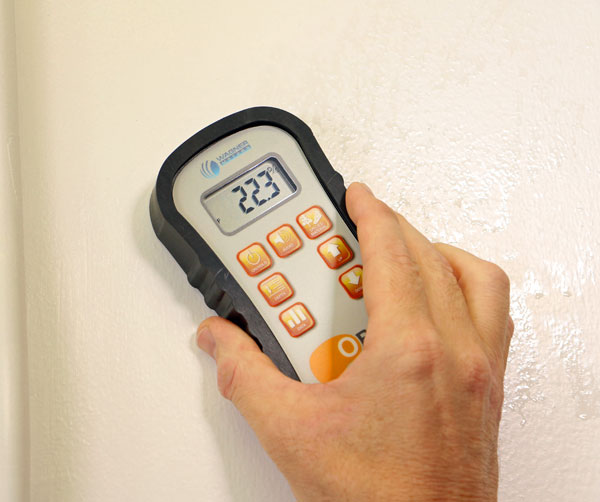How to Use a Wood Moisture Meter on Drywall
Using a moisture meter on drywall is important for both homeowners and professionals. It helps keep building materials durable and long-lasting.
Drywall, being porous, is susceptible to moisture absorption, which can lead to significant issues such as mold growth, structural damage, and aesthetic deterioration.
Understanding the acceptable moisture content in drywall is crucial.
This article will dive into the importance of moisture meters for drywall, how to effectively use them, and the acceptable moisture levels to maintain a healthy living environment.
- Do Pinless Moisture Meters Work on Drywall
- How to Use a Moisture Meter on Drywall
- Why It’s Important to Know If There’s Moisture in Your Drywall
- Not All Moisture Meters Have a Relative Mode
- FAQs
Equipping yourself with the proper knowledge and tools, you can safeguard your drywall against moisture-related problems and ensure a durable and visually appealing finish in your home or office.
Do Pinless Moisture Meters Work on Drywall?
Yes, the Orion series of pinless moisture meters, with their Relative Measurement mode, make it easy to detect wet spots and help locate leaks.
How to Use Moisture Meter on Drywall
Detecting moisture within your walls is crucial to maintaining the integrity and appearance of your drywall. Look for visible signs of moisture, such as discolored areas, musty odors, or crumbling drywall, which may indicate significant water damage.
Follow these simple steps to assess the moisture levels in drywall using an Orion® moisture meter accurately:
1. Activate the Relative Measurement Mode on your Orion® Moisture Meter
To do this, press and release the SPECIES/MATERIAL button until you see “REL” displayed on the main LCD screen and in the lower-left corner. Next, press the ON/HOLD button to activate the mode. Your moisture meter will now operate on a relative measurement scale (0-100), suitable for measuring non-solid wood or non-wood-based materials, including drywall. To return to Standard Measurement mode, press the SPECIES/MATERIAL button again.
2. Locate a Dry Spot and Record a Baseline Reading
Identify a known dry area on the wall and take a moisture reading. This baseline measurement will serve as a reference point for comparing other readings.
3. Scan the Wall for High-Moisture Areas
Examine the wall to identify spots with higher moisture content than the baseline reading. These areas indicate moisture issues within the drywall that may require further investigation or remediation.

Free Download – 5 Ways Pinless Moisture Meters Save You Time and Money
Why It’s Important to Know If There’s Moisture in Your Drywall
Drywall and moisture don’t get along. This is because drywall is very porous and easily absorbs and holds moisture. Even a small amount of excess moisture is too much for drywall. If you have excess moisture, you must either dry it or remove and replace it.
If you splash some water on drywall and then wipe it off right away, you should be OK. If it’s a larger amount of water, you can dry it off with a towel and then turn a fan on it until it dries. However, if drywall comes into contact with moisture over a longer period, it can be damaged beyond repair.
Even if you could dry it out, it wouldn’t look the same because it would have lost its shape, and if pressure is applied, it will crumble. The drywall is not load-bearing, so it won’t affect the building’s structural integrity, but it must be replaced.

Mold is also a problem because it doesn’t take much to get it growing in drywall. If you smell mold in your drywall, you should replace the affected panels immediately.
Not All Moisture Meters Have a Relative Mode
While it’s important to use a moisture meter on drywall, not all moisture meters have a relative mode. Using a relative scale may be the easiest way to test. Having a meter read something that is not the correct moisture content for the drywall may be confusing.
However, a relative mode may help the user remember the goal is to find the wettest areas. You must focus on ensuring that the drywall is dried out or replaced in these wetter areas. Also, a digital moisture meter can help a person trace down areas where water may enter the structure.
FAQs
Can I use a pin-type moisture meter on drywall?
While pin-type moisture meters can be used on drywall, pinless meters are generally recommended for non-invasive and less damaging moisture detection in drywall materials.
What are the signs that my drywall needs to be replaced due to moisture damage?
Some common signs of moisture damage in drywall include discoloration, musty odors, crumbling or warped panels, and visible mold growth. If you notice any of these signs, it is essential to address the issue promptly to prevent further damage.
How can I prevent moisture problems in my drywall?
Regularly check for leaks, proper ventilation, maintaining humidity levels, and using moisture-resistant materials like greenboard in moisture-prone areas can help prevent moisture problems in your drywall.
Consider reading Wood Moisture Meters Buying Guide: Pinless vs Pin-type next.
If you need tips on how to use a wood moisture meter, read our guide.
Tony Morgan is a senior technician for Wagner Meters, where he serves on a team for product testing, development, and also customer service and training for moisture measurement products. Along with 19 years field experience for a number of electronics companies, Tony holds a B.A. in Management and his AAS in Electronics Technology.
Last updated on February 6th, 2025





A moisture meter is real handy to have in my tool box at work. There’s been a site or two here lately that when had arrived we had found the contractors left the lifts of drywall outside with a tarp over them! Because of this I make all of my drywall employees carry a moisture meter with them. It’s really no fun doing the job twice!
Great post! You have well explained about how to test drywall moisture. Thanks for this informative article!